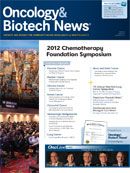Publication
Article
Oncology & Biotech News
Should Analysis of Circulating Tumor Cells Be Part of Metastatic Breast Cancer Management?
Author(s):
Circulating tumor cell counts can provide a variety of useful information for clinicians treating patients with metastatic breast cancer.
Massimo Cristofanilli, MD
Circulating tumor cell (CTC) counts can provide a variety of useful information for clinicians treating patients with metastatic breast cancer (MBC), according to Massimo Cristofanilli, MD, professor of Medicine and the G. Morris Dorrance Jr Endowed Chair in Medical Oncology at the Fox Chase Cancer Center in Philadelphia, Pennsylvania. At the 2012 Chemotherapy Foundation Symposium, Cristofanilli highlighted research that he believes supports the use of CTC testing in MBC management.
CTCs are tumor cells that have detached from solid tumors and entered the patient’s peripheral blood. In patients with MBC, studies have shown that the number of CTCs found in the peripheral blood before and during treatment is a predictor of progression-free survival (PFS) and overall survival (OS). CellSearch, which is manufactured by Veridex, LLC, is the only FDAapproved diagnostic test for CTC enumeration in metastatic disease.
Cristofanilli first discussed a 2004 study showing MBC patients with <5 CTCs/7.5 mL of peripheral blood experienced longer PFS than those with counts ≥5 mL—21.9 months and 10.9 months, respectively (J Clin Oncol. 2005;23[suppl; 524]). He next described findings from a pool analysis of six studies involving a total of 841 patients with progressive MBC (J Clin Oncol. 2011;29[suppl; abstr 10592]) that indicated that baseline levels of CTCs are the “best predictor of overall survival.”
CTCs also have demonstrated strong prognostic value for patients receiving endocrine therapy or chemotherapy alone; however, in patients receiving bevacizumab or HER2-targeted therapy, Cristofanilli noted, baseline CTCs did not predict OS (Breast Cancer Res. 2011;13[3]:R67).
In evaluating the role of CTCs in site of recurrence, Cristofanilli said investigators looked first to see if CTCs would help in evaluation of bone metastases, and they found that bone metastases alone and in combination with other sites, “were discriminated according to more or less than 5 CTCs.” Patients with either bone-only metastases or visceral metastases with CTC counts ≥5 did worse than those with CTCs <5 (Cancer. 2008;113[9]:2422-2430).
Cristofanilli also discussed the role of CTCs in measuring progression, where enumeration has proven beneficial as a complement to imaging (Clin Cancer Res. 2006;12[21]:6403-6409). Researchers have looked into the question of whether patients with >5 CTCs will progress faster, and found it to be “a very good determination of progression,” he said, particularly in visceral metastases.
Presenting new data on studies of patients (N = 146) with oligometastatic disease, Cristofanilli noted that typically these patients do better in terms of OS, but patients with >5 CTCs do worse. Researchers found a statistically significant difference in time to new metastatic sites for oligometastatic patients with >5 CTCs. Median survival was 40.2 months for patients with <5 CTCs versus 15.8 months for those with ≥5 CTCs. Time to new metastatic lesions also revealed a clear difference in median survival based on CTC counts in oligometastatic patients: 17.7 months for patients with <5 CTCs and 7.2 months for those with ≥5 CTCs. Thus, “with a standard test of CTCs, you can predict and follow very clearly the progression of disease,” Cristofanilli said.
Molecular monitoring is another area where CTC enumeration can play an important role, and the next step, said Cristofanilli, is to better understand the tumor markers expressed in CTCs. The CellSearch technology can enumerate and characterize CTCs for tumor markers that predict endocrine sensitivity (ER and Bcl-2) and resistance (HER2 and Ki67). A phase II trial (COMET-1) is in development to determine a CTC-endocrine therapy index (CTC-ETI) in ER-positive, HER2-negative MBC patients that can be used before a new endocrine therapy is initiated to identify patients likely to progress rapidly.




























%20(2)%201-Recovered-Recovered-Recovered-Recovered-Recovered-Recovered-Recovered-Recovered-Recovered-Recovered-Recovered-Recovered-Recovered-Recovered-Recovered-Recovered-Recovered.jpg?fit=crop&auto=format)
%20(2)%201-Recovered-Recovered-Recovered-Recovered-Recovered-Recovered-Recovered-Recovered-Recovered-Recovered-Recovered-Recovered-Recovered-Recovered-Recovered-Recovered-Recovered.jpg?fit=crop&auto=format)
